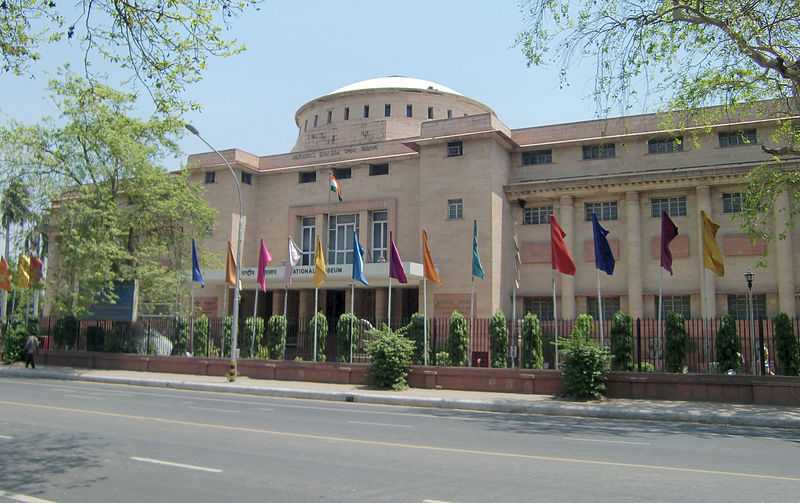Please wait ...
The National Museum in New Delhi has been operating since 1949 and is unbeatable when it comes to the collection of art paintings. The art gallery here features the biggest collection of miniature paintings in the country. Paintings by modern artists along with Mughal, Deccan, Rajasthan, Sikh and Kashmiri artists are showcased here. The artworks here range from the time periods of 10th to 20th century.

The National Museum in New Delhi, also known as the National Museum of India, is one of the largest museums in India. Established in 1949, it holds a variety of articles ranging from pre-historic era to modern works of art. It functions under the Ministry of Culture, Government of India. The museum is situated on Janpath. The blue–print of the National Museum had been prepared by the Gwyer Committee set up by the Government of India in 1946. The museum has around 200,000 works of art, both of Indian and foreign origin, covering over 5,000 years.
The current building of the National Museum was designed by the architect Ganesh Bikaji Deolalikar and the foundation stone was laid by Prime Minister Jawaharlal Nehru on May 12, 1955. Once the building was ready, the new museum was inaugurated by Dr. Sarvepalli Radhakrishnan, Vice-President of India on December 18, 1960. It stands today on the plot of land earmarked in Edwin L. Lutyens' plan for the Imperial Museum and was occupied by a small Museum of Central Asian Antiquities that housed the important collection of the explorer Sir Aurel Stein.

The National Museum building was planned to be built in phases to finally give it an octagonal shape. Its first phase was inaugurated in 1960 and the second was completed in 1989. For the third and final phase, a foundation stone was laid in December 18, 2017 and involves razing down of Archaeological Survey of India (ASI) building which has been moved to Dharohar Bhawan. As maps of the original plan suggest, roughly a quarter portion remains to be added for the completion of the building. The National Museum building has three floors with galleries radiating from a central garden court. The National Museum Institute, which is on the first floor of the museum and has a “deemed to be university” status, will be shifting to a new campus in Noida.
The museum has various artefacts from the Harappan Civilization also known as Indus Valley Civilization. It has the world's most representative collection of antiquities of the Harappan Civilization - over 3500 objects that are on permanent loan from the Archaeological Survey of India to the Museum. Most famous among the objects is the Dancing Girl made in Bronze which belongs to the early Harappan period, Skeleton excavated from Rakhigarhi in Haryana, Terracotta images of Mother Goddess and Clay Pottery. Apart from these the gallery has Sculptures in Bronzes & Terracotta, Bone Objects, Ivory, Steatite, Semi-Precious Stones, Painted Pottery and Jewellery items. Many seals are also on display which has been discovered during numerous excavations and were probably used for trading purposes. These seals depict bulls, elephants, unicorns, tigers, crocodiles, unknown symbols. On one of the seal, there is the depiction of Pasupati that has been interpreted as proto-Shiva. The gallery attempts to present the vibrancy of human civilization in India at par with the contemporary civilizations of Mesopotamia, Egypt and China.
A view of the pottery from the Harappan Gallery

Dancing Girl at Harappan Gallery
Maurya, Shunga and Satvahana Arts Gallery Artefacts

Buddha (Human Figure) at Kushana Gallery
Gupta Gallery Artefacts

Early Medieval artefacts at Medieval Art Gallery
Late Medieval artefacts at Medieval Art Gallery
Decorative Arts Gallery 1
Decorative Arts Gallery 2
View of the Mughal Miniature Paintings Section
A view of the Rajasthani Paintings Sections
Buddha's relics in the Museum
Shiva dancing Nataraja, Chola 12th century CE, Bronze

The birth of Jain Tirthankara Mahavira, from the Kalpa Sutra
Tanjore & Mysore Paintings Gallery
When one of the major sites of the Harappan civilization, Mohenjo Daro was excavated in the 1920s, archaeologists deposited its important finds first in the Lahore Museum, and then these were moved to Delhi by Mortimer Wheeler in anticipation of the construction of a Central Imperial Museum there. At the time of Partition, the issue of ownership of these objects arose and eventually the two countries agreed to share all the collections equally, although this was sometimes interpreted in literal sense, with several necklaces and girdles taken apart with half the beads sent to Pakistan and half retained in India. In the words of Nayanjot Lahiri, ‘the integrity of these objects were compromised in the name of equitable division’. Of the two most celebrated sculpted figures found in Mohenjo Daro, Pakistan asked for and received the steatite figure of a bearded male, dubbed the 'Priest King', while the National Museum of India retained the bronze statuette of the 'Dancing Girl', a nude bejeweled female. Considering that the major sites like Mohenjo Daro and Harappa belonged to Pakistan post- Partition, the collections in this gallery also grew out of the discoveries of the excavations made after the Indian independence in 1947 such as Daimabad, Rakhigarhi, and Dholavira etc.